Serpent Column
The Serpent Column (Ancient Greek: Τρικάρηνος Ὄφις Τrikarenos Οphis "Three-headed Serpent";[1] Turkish: Yılanlı Sütun "Serpentine Column"), also known as the Serpentine Column, Plataean Tripod or Delphi Tripod, is an ancient bronze column at the Hippodrome of Constantinople (known as Atmeydanı "Horse Square" in the Ottoman period) in what is now Istanbul, Turkey. It is part of an ancient Greek sacrificial tripod, originally in Delphi and relocated to Constantinople by Constantine the Great in 324. It was built to commemorate the Greeks who fought and defeated the Persian Empire at the Battle of Plataea (479 BC). The serpent heads of the 8-metre (26 ft) high column remained intact until the end of the 17th century (one is on display at the nearby Istanbul Archaeology Museums).[2]
_(cropped).jpg)

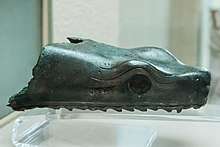
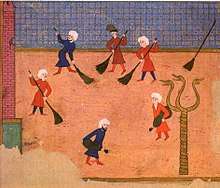
History
Provenance
The Serpentine Column has one of the longest literary histories of any object surviving from Greek and Roman antiquity – its provenance is not in doubt and it is almost 2,500 years old. Together with its original golden tripod and cauldron (both long missing), it constituted a trophy, or offering reminding of a military victory, dedicated to Apollo at Delphi. This offering was made in the spring of 478 BC, several months after the defeat of the Persian army in the Battle of Plataea (August 479 BC) by those Greek city-states in alliance against the Persian invasion of mainland Greece, during the Greco-Persian Wars. Among the writers who allude to the Column in the ancient literature are Herodotus, Thucydides, pseudo-Demosthenes, Diodorus Siculus, Pausanias the traveller, Cornelius Nepos and Plutarch. The removal of the column by the Emperor Constantine to his new capital, Constantinople, is described by Edward Gibbon, citing the testimony of the Byzantine historians Zosimus, Eusebius, Socrates, and Sozomenus.
Battle of Plataea
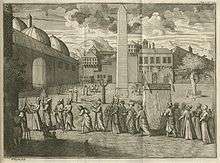
The invasion, a combined land and sea expedition, which began in 480 BC, fell under the command of the king himself, Xerxes I of Persia, and his brother-in-law and cousin Mardonius, who had been a close confidant of Xerxes' father, Darius I of Persia. Mardonius had led the first invasion into Greece ten years earlier, but ultimately was wounded and subsequently called back by Darius. Mardonius was replaced by Datis and Artaphernes' son who after initial success were decisively beaten at the hands of the Athenians in the Battle of Marathon in 490 BC.
Mardonius eventually persuaded Darius to mount a second invasion. It had twin objectives, the first of which was forcing the submission of those city states on mainland Greece who had refused to provide the symbolic tribute of ‘earth and water’ to the Persian king. The second objective was to punish the cities (initially Athens and Eretria) which had supported the Ionian Greeks[lower-alpha 1] who, under the leadership of Aristagoras of Miletus, revolted against Persian rule in 499 BC. The Athenians had sent twenty triremes in support of the revolt, and the Eretrians sent five. This struggle lasted until the defeat of the Ionians in a naval battle outside Miletus in 494 BC.
The Battle of Plataea followed the two simultaneous defeats of the Greeks at the Battle of Thermopylae, and the Battle of Artemisium. At Artemisium in August 480 BC, the storm-buffeted Persians confronted the much smaller fleet of Greek naval forces, who retreated to Salamis. After several indecisive clashes over at least three days, and the news of the defeat on land, the strategy of the Greek allies was in ruins. Nothing could prevent the Persian advance and ultimately the occupation and pillage of Athens. Only the brilliant strategy, planning and careful reasoned actions of the Athenian general Themistocles restored the situation. He arranged to evacuate the inhabitants of Athens before the invasion to the island of Salamis. Then he persuaded the reluctant Peloponnesian cities to stop and fight a naval battle in the Straits of Salamis, rather than retreat to the Isthmus, thus drawing Xerxes in to attack the Greek fleet in the straits (September, 480 BC).
After Salamis, Xerxes withdrew to Sardis, but left a land force in Thrace, under the generalship of the experienced campaigner, Mardonius. He re-possessed Athens in the spring of 479 BC, and after the failure of diplomacy conducted by Alexander of Macedon on behalf of the Persians, to persuade the Athenians to a separate peace, the war continued. On learning that a Spartan force was on the march from the Peloponnese, Mardonius set fire to Athens again and removed his force to a strategic position in Boeotia, north of the river Asopus. The Greeks under the leadership of Pausanias, Regent of Sparta,[lower-alpha 2] drew up on high ground in defensive positions south of the river Asopus and above the plain of Plataea. After days of skirmishing and changes of position on the Greek side, Mardonius launched a full attack. The result of the complex battle was complete victory for the Spartans, under the leadership of Pausanias. Mardonius was killed and the Persians fled in confusion led by Artabazus, the Persian second in command.
The significance of the Battle of Plataea
The Greek victories at Plataea and contemporaneous naval battle at Mycale had the result that never again would the Persian Empire launch an attack on mainland Greece. Afterwards, Persia pursued its policies by diplomacy, bribery and cajolement, playing one city state against another. But, by these victories, and through the Delian League, Athens was able to consolidate its power in the flowering of Athenian democracy in 5th century Athens, under the leadership of Pericles, son of Xanthippus.
After the Battle of Plataea, the last battle of the Greco-Persian Wars, the Greeks erected a bronze column of three intertwined snakes,[1] whose bodies formed the column, to commemorate the 31 Greek city-states that participated in the battle. According to Herodotus, the bronze column was built using the bronze from the melted-down Persian weapons. A golden tripod topped the column, made by Persian weapons, and the whole monument was dedicated to the god Apollo and was placed next to the altar of Apollo at Delphi.
In ancient writers
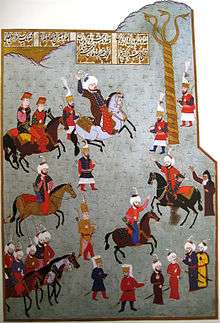
After describing the Greek victory at Plataea, in 479 BC, Herodotus recounts the collection of rich spoils, by the Helots, (the Spartan underclass), who had taken part in the battle, and then records the decision of the Greek cities to dedicate an offering to Apollo at Delphi:[1][3]
Having brought all the loot together, they set apart a tithe for the god of Delphi. From this was made and dedicated that tripod which rests upon the bronze three-headed serpent, nearest to the altar.
— Herodotus Histories 9.81.1
In the same chapter, Herodotus records that dedications were also made to Zeus at Olympia and to Poseidon at the Isthmus. It is significant that precedence was given to Apollo at Delphi, despite the ambiguities in the responses of the Delphic oracle about the outcome of the invasion, and a suspicion that Delphi was sympathetic to the Persians.
Thucydides and pseudo-Demosthenes
Pausanias, full of arrogance over his victory at Plataea and the subsequent ease with which he punished the Theban leaders for their support of the Persians, ordered a dedication on the column ascribing victory to himself alone. Later, it was discovered he had been in negotiations with the Persians and the Helots of Sparta to stage a rebellion, and set himself up as Tyrant. Although his treachery was, at first, disbelieved in Sparta, it was eventually confirmed by the Ephors of Sparta through his personal slave, and he was killed. Thucydides describes[4] the Spartan suspicion that Pausanias was at the point of committing treason and going over to the Persians, citing the Serpentine column affair as evidence. Pausanias provided other causes for suspicion in his disregard of laws, his admiration of the Persians, and his dissatisfaction with the status-quo. Upon examination of the rest of his behaviour, the Spartans recalled that when the tripod at Delphi was first erected, Pausanias had thought fit, of his own accord, to have a diptych engraved upon it with the inscription:
- ‘Pausanias, commander-in-chief of the Greeks,
- when he had destroyed the army of the Medes,
- dedicated this memorial to Phoebus (Apollo).’
The Lacedaemonians, at once, removed the diptych from the tripod and engraved the names of the cities, who had joined together against the Persians and set up the offering.
Pseudo-Demosthenes[5] gives a significantly different account of the train of events. In a speech, "Against Neaira", the orator recalls the conduct of Pausanias after the defeat of the Persians in the battle of Plataea over the Serpentine column: "Pausanias, King of the Lacedaemonians, caused a diptych to be inscribed on the tripod at Delphi, [which those Greeks, who had fought as allies in the battle of Plataea and in the naval engagement at Salamis had together made from the spoils taken from the Barbarians and had set up in honour of Apollo as a memorial to their bravery], as follows: 'Pausanias, commander-in-chief of the Greeks, when he had destroyed the army of the Medes dedicated this memorial to Phoebus (Apollo)', as if the work and the offering were his alone, and not from the allies together. The Greeks were enraged and the Plataeans obtained leave to bring a suit, on behalf of the allies, against the Lacedaemonians for 1,000 talents at the Amphictyonic council;[lower-alpha 3] and they compelled the Lacedaemonians to erase the inscription and inscribe the names of those cities which had shared in the work".
The orator goes on to argue that this action rankled with the Lacedaemonians and was a strong motive, 50 years later, in their influencing the Theban night attack on Plataea in 431 BC, which was the first action in the Peloponnesian war described in Thucydides book 2.
Diodorus Siculus
Diodorus Siculus, writing in the 1st century BC, says that a couplet composed by the poet Simonides, replaced Pausanias’ haughty personal dedication:[6]
The saviours of Greece at large dedicated this,
having delivered the cities from wretched servitude.
Pausanias the Traveller
In the second century AD, Pausanias, the travel writer, noticed the monument at Delphi:[7] "The Greeks together, from the spoils taken at the battle of Plataea, dedicated a gold tripod set on a bronze serpent. The bronze part of the offering was preserved there, even at my time, but the Phocian leaders did not leave the gold in place in the same way." The Phocian General Philomelus took the treasures in 345/4 BC to pay for mercenaries during the Third Sacred War, an act of extreme sacrilege, which resulted in the expulsion of Phocians from the Amphictyonic league, by Philip II of Macedon, and to the imposition on them of a fine of 400 talents.[3]
Even at the time of Pausanias’ visit, the Sacred Way, leading up to the temple of Apollo, was lined on both sides with monuments, statues and treasuries commemorating important events in Greek History. "Closest to the altar", as Herodotus says, was the Serpentine column, the base of which has been found, as has the base of the altar, which was dedicated by the Chians[8] [and Appendix A].Above these loomed the great bronze statue of Apollo, and, on the architrave of the temple, shields commemorating a Greek victory over the Gauls. Pausanias also mentions [9] the offering to Zeus at Olympia, [paragraph above] and listed the names of the cities engraved upon it.
In Gibbon
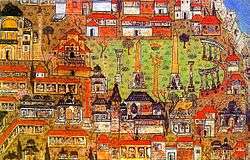
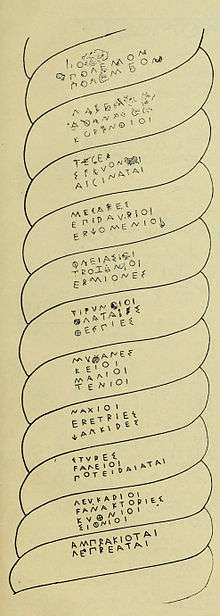
In his History of the Decline and Fall of the Roman Empire (1776–1789), Edward Gibbon refers to the Serpentine Column both in Chapter 17 (on the founding of Constantinople) and in Chapter 68 (on the triumphal entry of Mehmet II, the Conqueror into Constantinople on 29 May 1453):
The Circus or Hippodrome was a stately building about 400 paces in length and 100 in breadth. The space between the two metae or goals was filled with statues and obelisks; and we may still remark a very singular fragment of antiquity, the bodies of three serpents twisted into one pillar of brass. Their triple heads had once supported the golden tripod which, after the defeat of Xerxes, was consecrated in the temple of Apollo at Delphi, by the victorious Greeks."[10]
... and again...
From the first hour of the memorable 29th of May, disorder and rapine prevailed in Constantinople, till the eighth hour of the same day, when the Sultan himself passed in triumph through the gate of St. Romanus. He was attended by his vizars, bashaws, and guards, each of whom (says a Byzantine historian) was as robust as Hercules, dexterous as Apollo, and equal in battle to any ten of the race of ordinary mortals. The conqueror gazed in satisfaction and wonder on the strange though splendid appearance of the domes and palaces, so dissimilar from the style of Oriental architecture. In the hippodrome, his eye was attracted by the twisted column of the three serpents, and, as a trial of his strength, he shattered with his iron mace or battleaxe the under-jaw of one of these monsters, which in the eyes of the Turks were the idols or talismans of the city.[11]
In other sources
The somewhat chequered history of the monument, after its removal to Constantinople, may be deduced from various sources. According to W. W. How & J. Wells, it was converted into a triple-mouthed fountain by a later Emperor, was seen and described by travellers from 1422 onwards, and was thrown down in 1700, when the serpents heads were broken off. Marcus N. Tod says the level of the ground was raised in 1630, and the inscribed portion of the monument was then hidden. The base of the column was excavated in 1855, under the supervision of Charles Thomas Newton. Fifteen of the serpents’ coils had been hidden and the inscription, beginning at the 13th coil and ending at the 3rd was revealed. It was deciphered by C. Frick in 1856, by Ernst Fabricius in 1886 and by others since.
The 13th coil carries the Laconic inscription:
"Those who fought the war", followed on coils 12 to 3 by the names of 31 city states. This contains eight cities not named in Herodotus, book 9.28 as being present at the battle of Plataea, and excludes Pale, in Cephalonia, which Herodotus did include. In the aforementioned paragraph Pausanias lists the names on the offering to Zeus at Olympia, which exclude four cities inscribed on the Serpentine column. Perhaps this is a simple oversight by a copyist. Although the cities inscribed on the column exclude other cities mentioned by Herodotus as participating in the war, it is clear that the memorial relates to the Great Persian War as a whole, not just the battle of Plataea. The lists of states given by the three sources are set out in Appendix B. Coils 12 and 13 have been scarred and dented by sabre cuts, which made the inscriptions difficult to decipher. The dedication, said by Diodorus to have been composed by Simonides [paragraph above] has not been found. One of the serpent heads survives in the Museum of Antiquities, Istanbul. This head has its under-jaw missing, a linkage to Edward Gibbon's colourful description of the conqueror's triumphal entry into Constantinople on 29 May 1453.
Current status
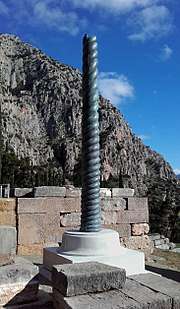
Pausanias informs us that roughly a hundred years later, the Phoceans used the golden tripod to fund their military during the holy war involving the Oracle of Delphi. Constantine the Great moved the Serpent Column to Constantinople to decorate the spina (central line) of the Hippodrome of Constantinople, where it still stands today.
The top of the column was adorned with a golden bowl supported by three serpent heads. The bowl was destroyed or stolen during the Fourth Crusade. Many Ottoman miniatures show the serpent heads were intact in the early decades following the Turkish conquest of the city.[12]
Ahmed Bican, from Gallipoli, has given a short description of the Column in his Dürr-i Meknûn, written around the time of the Fall of Constantinople. He states that it is a hollow bronze of intertwined snakes, threeheaded, a talisman for the citizens against snake bites.[13]
Between fifty and one hundred years after the Turkish conquest of Constantinople, the jaw of one of the three serpent heads was documented missing. The accepted version states that Mehmed II shattered it upon entering the city in triumph as its conqueror.[14]
Later, at the end of the 17th century, all three of the serpent heads were destroyed. Silahdar Findiklili Mehmed Aga relates in Nusretname ("The Book of Victories") that the heads simply fell off on the night of October 20, 1700.[15] The upper jaw of one of the heads is on display at the Istanbul Archaeology Museum.
In 2015 a bronze cast copy of the serpent column was made and set up in the Archaeological Site of Delphi.
See also
- Delian League
- Ionian Revolt
- Iron pillar of Delhi
- Pausanias (general)
- Pericles
- Xerxes I of Persia
Footnotes
- Ionian Greek cities on the eastern coast of the Aegean, subject to Persia.
- Pausanias was regent to his cousin, King Pleistarchus, son of Leonidas, who was still a minor.
- The Amphictyonic Council was a meeting of 12 city states with responsibility over the sanctuary at Delphi.
References
- Τρικάρηνος ὄφις ὁ χάλκεος, i.e. "the bronze three-headed serpent"; see Herodotus (1920). "9.81.1". Histories. with an English translation by A. D. Godley. Cambridge: Harvard University Press.
συμφορήσαντες δὲ τὰ χρήματα καὶ δεκάτην ἐξελόντες τῷ ἐν Δελφοῖσι θεῷ, ἀπ᾽ ἧς ὁ τρίπους ὁ χρύσεος ἀνετέθη ὁ ἐπὶ τοῦ τρικαρήνου ὄφιος τοῦ χαλκέου ἐπεστεὼς ἄγχιστα τοῦ βωμοῦ, καὶ τῷ ἐν Ὀλυμπίῃ θεῷ ἐξελόντες, ἀπ᾽ ἧς δεκάπηχυν χάλκεον Δία ἀνέθηκαν, καὶ τῷ ἐν Ἰσθμῷ θεῷ, ἀπ᾽ ἧς ἑπτάπηχυς χάλκεος Ποσειδέων ἐξεγένετο, ταῦτα ἐξελόντες τὰ λοιπὰ διαιρέοντο, καὶ ἔλαβον ἕκαστοι τῶν ἄξιοι ἦσαν, καὶ τὰς παλλακὰς τῶν Περσέων καὶ τὸν χρυσὸν καὶ ἄργυρον καὶ ἄλλα χρήματα τε καὶ ὑποζύγια.
See also τρικάρηνος, ὄφις. Liddell, Henry George; Scott, Robert; A Greek–English Lexicon at the Perseus Project.
Having brought all the loot together, they set apart a tithe for the god of Delphi. From this was made and dedicated that tripod which rests upon the bronze three-headed serpent,1 nearest to the altar; another they set apart for the god of Olympia, from which was made and dedicated a bronze figure of Zeus, ten cubits high; and another for the god of the Isthmus, from which was fashioned a bronze Poseidon seven cubits high. When they had set all this apart, they divided what remained, and each received, according to his worth, concubines of the Persians and gold and silver, and all the rest of the stuff and the beasts of burden.
1 The bronze three-headed serpent supporting the cauldron was intended apparently to commemorate the whole Greek alliance against Persia. The serpent pedestal still exists, in the Atmeydan (formerly Hippodrome) at Constantinople, whither it was transported by Constantine; it has been fully exposed and its inscription deciphered since 1856. The names of thirty-one Greek city-states are incised on eleven spirals, from the third to the thirteenth. For a fuller account see How and Wells' note ad loc. - Istanbul Governor's official website – The Serpent Column. web page Archived 2007-08-02 at the Wayback Machine
- Folio Society edition of the History of the Decline and Fall of the Roman Empire 1984 & 1990.
- Translated from Thucydides, Book 1.132.
- Translated from pseudo-Demosthenes, "Against Neaira" 97 [Apollodorus?].
- Translated from Diodorus Siculus, book 11.33.2.
- Translated from Pausanias, Description of Greeks, book 10.13.9.
- A Commentary on Herodotus, How & Wells, Oxford at the Clarendon Press, first published 1912.
- Selections of Greek Historical Inscriptions, Marcus N Tod, Oxford at the Clarendon Press, 1933.
- Gibbon, Op. cit., Chapter 17
- Gibbon, Op. cit., Chapter 68
- Mavrovitis, Jason C. (2000). "The Atmeidan, or Hippodrome in Constantinople" – web page
- Laban Kaptein (ed.), Ahmed Bican, Dürr-i meknûn, p. 186 and § 7.110). Asch 2007. ISBN 978-90-902140-8-5
- Menage 1964, pp. 169–70.
- Menage 1964, pp. 172–73.
Sources
Ancient sources
- Herodotus (1920). The Histories. with an English translation by A. D. Godley. Cambridge: Harvard University Press. At the Perseus Project of Tufts University.
- Diodorus Siculus (1967). Library. in Twelve Volumes with an English Translation by C. H. Oldfather. Cambridge, Mass.; London. At the Perseus Project of Tufts University.
Modern sources
- Menage, V.L. (1964). "The Serpent Column in Ottoman Sources". Anatolian Studies. Anatolian Studies, Vol. 14. 14: 169–73. doi:10.2307/3642472. JSTOR 3642472.
Further reading
- Volume 4 of the Cambridge Ancient History
- G.B.Grundy, The Great Persian War [library of US Congress, catalogue card number: 71-84875]
- Broken Bits of Byzantium (1891), by C. G. Curtis and Mary A. Walker, Part II, as referred to in Broken Bits of Byzantium by J. Freely in, Istanbul 1, Myth to Modernity, Selected Themes, p. 23-24.
- William Custis West, Greek Public Monuments of the Persian Wars, chapter III: Panhellenic monuments of the Persian Wars in General, no. 25: Gilded tripod supported by column of three entwined serpents, dedicated at Delphi.
- Thomas F. Madden, The Serpent Column of Delphi in Costantinople: Placement, Purposes, and Mutilations, Byzantine and Modern Greek Studies 16 (1992), pp. 111–45.
- The serpent column and the covenant of Plataia in Benjamin Dean Meritt, H. T. Wade-Gery, Malcolm Francis McGregor, The athenian tribute lists, vol. III, The American School of Classical Studies at Athens, Princeton, New Jersey, 1950, pp. 95–105.
- Paul Stephenson, The Serpent Column: A Cultural Biography, Oxford University Press 2016.
External links
| Wikimedia Commons has media related to Serpent Column. |
- Encyclopædia Britannica Online – Ancient Greek Civilization – The Persian Wars
- Byzantium 1200 | Delphi Tripod computer reconstruction
- I.M.Varvitsiotis, "The forgotten three-headed snake"
- "Epigraphic Sources for Early Greek Writing"
- The Atmeidan, or Hippodrome – in Constantinople
- Reconstruction of the tripod of Plataea
- Phokian Script: The Serpent Column